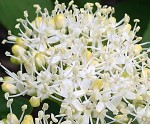 Pagoda dogwood, also known as green osier, is a small deciduous tree or large shrub native to Eastern North America west to Minnesota and south to Georgia and Missouri where they grow in woodland understories, stream banks, swamp edges, clearings, and roadsides. It is a member of the dogwood family, Cornaceae, that includes cornelian cherry. The horizontal branches become smaller as they go up the stem and give rise to the pagoda shape that gives the tree its common name, pagoda tree. The elliptical to ovate leaves grow in terminal clusters and are up to five inches long and two inches wide. They are hairy on the lower side, have wavy margins, and become yellow to bright red in the fall. Unlike other dogwoods the leaves are alternately arranged rather than opposite. The small, fragrant, cream-colored flowers appear in domed two to five inch wide clusters called cymes in mid to late spring and are followed in late summer by blue-black berries that are attractive to birds and black bears. The plants are attractive as patio trees, as well as in hedges, woodland, and bird gardens. The genus name Cornus comes from the Latin word for corneal cherry (Cornus mas) and was probably derived from the Latin word cornus meaning horn and eluding to the strength of the wood. The specific epithet alternifolia comes from the Latin words alternus meaning opposite and folia meaning leaf, referring to the arrangement of the leaves.
Pagoda dogwood, also known as green osier, is a small deciduous tree or large shrub native to Eastern North America west to Minnesota and south to Georgia and Missouri where they grow in woodland understories, stream banks, swamp edges, clearings, and roadsides. It is a member of the dogwood family, Cornaceae, that includes cornelian cherry. The horizontal branches become smaller as they go up the stem and give rise to the pagoda shape that gives the tree its common name, pagoda tree. The elliptical to ovate leaves grow in terminal clusters and are up to five inches long and two inches wide. They are hairy on the lower side, have wavy margins, and become yellow to bright red in the fall. Unlike other dogwoods the leaves are alternately arranged rather than opposite. The small, fragrant, cream-colored flowers appear in domed two to five inch wide clusters called cymes in mid to late spring and are followed in late summer by blue-black berries that are attractive to birds and black bears. The plants are attractive as patio trees, as well as in hedges, woodland, and bird gardens. The genus name Cornus comes from the Latin word for corneal cherry (Cornus mas) and was probably derived from the Latin word cornus meaning horn and eluding to the strength of the wood. The specific epithet alternifolia comes from the Latin words alternus meaning opposite and folia meaning leaf, referring to the arrangement of the leaves.
Type: Deciduous small tree or large shrub
Outstanding Feature: Fall coloration; flowers
Form: Round to oval
Growth Rate: Moderate
Bloom: Small cream-colored flowers in two to five inch wide domed clusters in mid to late spring
Size: 15-35’ H x 20-32’ Wnative plant
Light: Partial shade
Soil: Humusy, consistently moist, well-drained, acidic
Hardiness: Zones 3-7
Care: Mulch root zone in hot climates
Pests and Diseases: Susceptible to leaf spot, twig and leaf blights, root rot, canker, scale, leaf minor, borers.
Propagation: Softwood or hardwood cuttings, seed
Outstanding Selection: ‘Argentea’ (leaves with white margins)